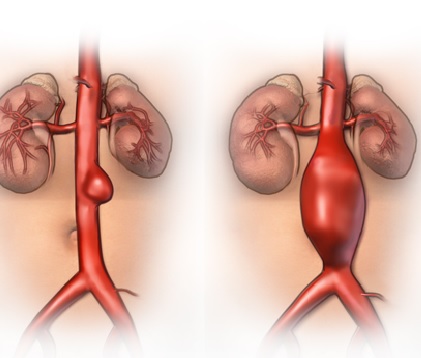Abdominal aortic aneurysm (AAA) is an enlargement that occurs in the section of the aorta located in the abdominal cavity. It usually progresses without symptoms and poses a life-threatening risk due to sudden rupture. It is particularly associated with factors such as advanced age, male gender, and smoking. This article discusses in detail the definition, risk factors, diagnostic methods, and modern treatment options for abdominal aortic aneurysm.

Where is the Abdominal Aorta?
The aorta is the largest artery that emerges from the heart and carries oxygenated blood to the body. After leaving the heart, it passes through the chest cavity to reach the abdominal area. The abdominal aorta extends from below the diaphragm, passing through the middle of the abdominal cavity to where the arteries to the legs branch off.
In this region, the normal aortic diameter is about 2-2.5 cm. If this diameter is 3 cm or more, it is defined as an “aneurysm”.
Why Does Abdominal Aortic Aneurysm Occur?
The main factors contributing to AAA development are:
- Smoking: It is the most significant and modifiable risk factor. Smoking weakens the vessel walls, contributing to the development and progression of vascular diseases.
- Advanced age: The prevalence increases, especially in men over the age of 65.
- Family history: The risk of developing an abdominal aortic aneurysm (AAA) increases significantly if a first-degree relative has a history of the condition.
- Atherosclerosis (hardening of the arteries): A loss of elasticity in the arterial walls occurs due to the buildup of calcium and cholesterol, leading to vessel stiffening and narrowing.
- Male gender: The condition is 4 to 6 times more common in men than in women.
- Hypertension: Constant high blood pressure puts stress on the vessel wall, promoting its weakening and eventual dilation.
What Are the Symptoms?
AAA usually progresses silently. It often doesn’t show symptoms and is incidentally detected during imaging for another health issue. However, in some cases, the following symptoms may occur:
- Dull pain in the abdomen or lower back
- Feeling of a pulsating mass in the abdomen (in thin individuals)
- Pain radiating to the back or leg
- In case of aneurysm rupture: Sudden and severe abdominal or back pain, loss of consciousness (fainting), and a rapid drop in blood pressure may occur.
This last situation is a life-threatening emergency that requires immediate surgical intervention.
How is Abdominal Aortic Aneurysm Diagnosed?
• Abdominal Ultrasonography
It’s especially used for screening purposes. It’s a simple, quick and radiation-free method.
• CT Angiography (Computed Tomography)
It shows in detail the diameter, length of the aneurysm and its relationship with surrounding organs. It’s preferred for surgical planning.
• MR Angiography
It’s a radiation-free alternative. It may be preferred especially in patients with impaired kidney function.
Who Should Get Screened?
In some countries, a one-time abdominal aortic aneurysm screening is recommended for men over 65. Turkey does not yet have a national screening program. However, the following groups are considered at risk:
- Men over 65 who are active or former smokers
- Those with a family history of AAA
- Individuals diagnosed with vascular disease
What Are the Treatment Options?
The treatment approach is determined based on the size and growth rate of the aneurysm:
1. Monitoring and Follow-up
- Patients with aortic diameter between 4.0-5.4 cm and low growth rate are followed up every 6-12 months.
- Blood pressure control, smoking cessation, and lifestyle modifications are recommended.
2. Surgical Intervention
Surgery is recommended if the aneurysm diameter is 5.5 cm or larger, or if rapid growth (more than 0.5 cm >per year) is detected.
a. Open Surgery
- The aneurysmal segment is surgically removed through an abdominal incision.
- An artificial graft is stitched in place.
- The recovery period after surgery is longer (1-2 weeks hospital stay, 4-6 weeks recovery).
b. Endovascular Aortic Repair (EVAR)
- Entering through the groin area, a stent-graft is placed inside the blood vessel.
- The aneurysm is closed from the inside, eliminating the risk of rupture.
EVAR advantages:
- Shorter hospital stay (1-2 days)
- Lower risk of bleeding and infection
- Faster recovery process (3-4 days)
However, this method may not be suitable for every patient. Anatomical factors such as the shape and length of the vessel, and leg vessels should be evaluated in detail.
Abdominal aortic aneurysm is a serious vascular disease that often progresses without symptoms, but can be fatal if ruptured. Regular screening in high-risk individuals, early diagnosis, and appropriate treatment can be life-saving. Thanks to endovascular treatments, it is now possible to offer less risky and more comfortable solutions.
